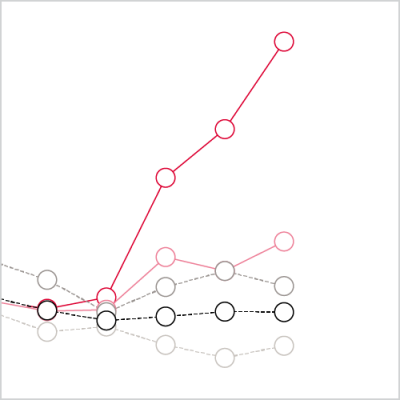Weekly registered deaths in 2020: tracker COVID-19 chart series
26 May 2020

This chart compares the total number of deaths registered each week to the average, minimum and maximum number of deaths reported in the previous 5 years (2015-2019).
Please note that we are no longer updating this chart. It was last updated on 26 May 2020.
-
The number of deaths in week ending 15 May (14,573) exceeds the average for the same week in the previous 5 years by 4,385. This excess is higher than the number of deaths where COVID-19 was mentioned on the death certificate (3,810).
-
With COVID-19 related deaths excluded, weekly deaths have reduced but still exceed the maximum registered in the same week over the previous 5 years.
-
Some death registrations in the week ending 15 May were delayed by the Early May Bank Holiday reducing total registrations in the previous week and increasing total registrations in this week’s count.
-
The total number of excess deaths since week ending 13 March, when COVID-19 deaths were first registered, has reached 53,846 in England and Wales.
Previous updates
-
The number of deaths in week ending 8 May (12,657) exceeds the average for the same week in the previous 5 years by 3,081. This is lower than the number of deaths where COVID-19 was mentioned on the death certificate (3,930).
-
With COVID-19 related deaths excluded, for the first time in six weeks, weekly deaths are lower than the 5-year average of the previous five years.
-
Death registrations in the week ending 8 May were affected by the Early May Bank Holiday which will reduce the number of deaths reported
- The number of deaths in week ending 1 May (17,953) exceeds the average for the same week in the previous 5 years by 8,012. The number of excess deaths has fallen in each of the last two weeks but still remains high.
- With COVID-19 related deaths excluded, for the last six weeks, weekly deaths have been at or higher than the maximum of the previous five years.
- The non-COVID-19 excess does not appear to be due to diagnosing of COVID-19 deaths as caused by other respiratory disease. Deaths where respiratory disease is the underlying cause were only 95 higher in the week ending 1 May than the average of 1,367 for the same week over the previous five years, accounting for only a fraction (5%) of the non-COVID 19 related excess (1,977).
- The increase in non-COVID-19 related deaths suggests either underdiagnosis of the role of the virus in the cause of some deaths, or indirectly caused deaths. For instance, due to people not seeking treatment, disruption to usual medical care, or other causes related to the pandemic and social distancing measures.
- The number of deaths in the week ending 24 April (21,997) exceeds the average for the same week in the previous 5 years by 11,539.
- With COVID-19 related deaths excluded, for the last 5 weeks, weekly deaths have been at or higher than the maximum of the previous 5 years.
- The non-COVID-19 excess does not appear to be due to diagnosing of COVID-19 deaths as caused by other respiratory disease. Deaths where respiratory disease is the underlying cause were only 131 higher in the week ending 24 April than the average of 1,443 for the same week over the previous five years, accounting for only a fraction (4%) of the non-COVID 19 related excess (3,302).
- The increase in non-COVID-19 related deaths suggests either underdiagnosis of the role of the virus in the cause of some deaths, or indirectly caused deaths. For instance, due to people not seeking treatment, disruption to usual medical care, or other causes related to the pandemic and social distancing measures.
- The number of deaths in week ending 17 April 2020 (22,351) exceeds the average for the same week in the previous 5 years by 11,854.
- With COVID-19 related deaths excluded, for the last four weeks, weekly deaths have been at or higher than the maximum of the previous five years.
- The non-COVID-19 excess does not appear to be due to diagnosing of COVID-19 deaths as caused by other respiratory disease. Deaths where respiratory disease is the underlying cause were only 268 higher in the week ending 17 April 2020 than the average of 1,508 for the same week over the previous five years, accounting for only a fraction (9%) of the non-COVID 19 related excess (3,096).
- The increase in non-COVID-19 related deaths suggests either underdiagnosis of the role of the virus in the cause of some deaths, or indirectly caused deaths. For instance, due to people not seeking treatment, disruption to usual medical care, or other causes related to the pandemic and social distancing measures.
Further reading
Work with us
We look for talented and passionate individuals as everyone at the Health Foundation has an important role to play.
View current vacanciesThe Q community
Q is an initiative connecting people with improvement expertise across the UK.
Find out more

